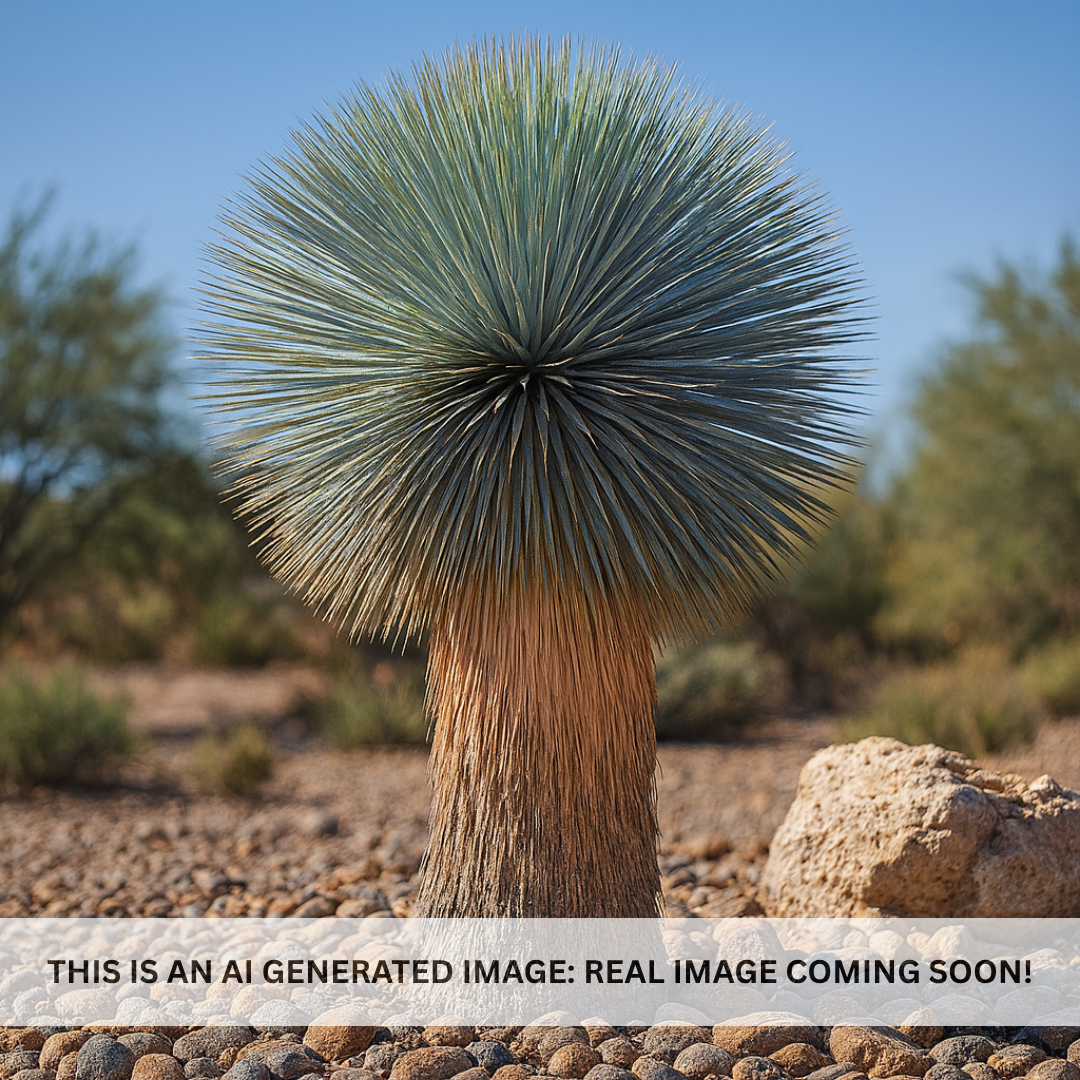My Store
Beaked Yucca
Beaked Yucca
Couldn't load pickup availability
Plant Type: perennial, evergreen succulent tree-form yucca**
Plant Height: 8–15 feet (can reach up to 20 feet in maturity)**
Spread: 4–6 feet
Flower Color: creamy white (large, showy clusters)**
Sun Exposure: Full sun
Beaked Yucca / Yucca rostrata: The King of Desert Elegance
Yucca rostrata, commonly known as the Beaked Yucca, is one of the most graceful and architectural yuccas found in desert landscapes. Native to the Chihuahuan Desert of northern Mexico and West Texas, this species is celebrated for its perfectly symmetrical crown of fine, blue-gray leaves, clean trunk, and soft, rounded silhouette.
Often called the “Palm of the Desert,” Y. rostrata combines strength and beauty in equal measure—offering the striking vertical structure of a palm with the drought tolerance and resilience of a true desert native. Its refined form makes it a landscape centerpiece that radiates elegance in any Arizona garden.
Key Features of Yucca rostrata
The Beaked Yucca develops a dense, spherical rosette of narrow, silvery-blue leaves that radiate outward in all directions, forming a soft, symmetrical ball atop a tall, slender trunk. Each leaf is 12–24 inches long, slightly flexible, and ends in a sharp but non-lethal spine. The overall texture is much softer than many other yuccas, giving it an airy, feathery look that moves gently in the wind.
Over time, Y. rostrata forms a woody trunk that can reach 10–15 feet tall, sometimes branching as it ages. In late spring to early summer, mature plants produce towering flower spikes rising up to 2–3 feet above the rosette, densely packed with creamy white, bell-shaped blooms that attract hummingbirds, moths, and bees.
After flowering, the dried bloom stalk can be cut to maintain the plant’s pristine appearance. The old leaves naturally form a skirt around the trunk, which can be trimmed for a clean “palm-style” look or left intact for a natural desert aesthetic.
Growing and Care Tips
Yucca rostrata thrives in full sun and sharply draining soil. It performs exceptionally well in sandy, rocky, or decomposed granite beds and loves open, exposed areas where it can show off its silhouette against the sky.
Water deeply but infrequently during establishment—every 14–21 days depending on temperature and soil type. Once established, it becomes one of the most drought-tolerant yuccas, requiring irrigation only every 4–6 weeks during the hottest months and rarely in winter.
It is cold hardy to around 0°F, making it suitable for both low and high desert landscapes. Growth is slow to moderate, but its longevity (often 50–100 years) ensures a permanent, sculptural presence in the garden.
Pruning needs are minimal—remove dead leaves or spent flower stalks as desired. Wear gloves when handling; the leaf tips are firm but not dangerously sharp.
For container growing, choose a tall, heavy pot with excellent drainage and a gritty cactus mix.
Landscaping Uses
The Beaked Yucca is a signature plant for luxury desert and modern landscapes, combining refined structure with natural grace. Its sculptural form and soft silver color make it perfect as a standalone focal point, entryway accent, or centerpiece in rock gardens.
It pairs beautifully with Blue Glow Agave, Golden Barrel Cactus, Red Yucca (Hesperaloe parviflora), or Desert Spoon (Dasylirion wheeleri) for balanced compositions. Use it to bring height and movement to xeriscapes or to soften hard architectural lines.
In groups of three or more, Y. rostrata creates an oasis-like rhythm of form and texture. Under landscape lighting, its silvery-blue leaves reflect beautifully, giving the plant a luminous, moonlit quality at night.
Summary
The Beaked Yucca (Yucca rostrata) is the epitome of desert refinement—elegant, symmetrical, and enduring. With its silver-blue foliage, clean trunk, and stately silhouette, it’s a masterpiece of natural design that thrives in Arizona’s toughest conditions. Low maintenance, long-lived, and endlessly graceful, this species elevates any landscape with structure, color, and sophistication.
Three Timbers Installation Guide (Feel Free to Follow):
Yucca rostrata Planting Guide:
Location: Full sun; choose a bright, open site with at least 8 hours of direct light daily. Handles reflected heat and exposed sites beautifully.
Soil: Use sharply draining soil composed of cactus mix, decomposed granite, and coarse sand or pumice. Avoid compact or clay-heavy soils.
Spacing: Allow 4–6 feet between plants or nearby structures to accommodate mature spread and airflow.
Planting Depth: Keep the base level with or slightly above soil grade. Avoid burying the trunk or crown.
Support: Large specimens may need temporary staking until roots are fully established; remove supports once stable.
Watering Guide:
Watering After Planting: Water deeply once after installation to settle soil. Then allow it to dry fully before watering again. During the first 3–4 months, water every 14–21 days depending on heat and drainage.
When is the Plant Established? Yucca rostrata is considered established after 9–12 months, once new leaf growth appears and color deepens to its signature silvery-blue tone.
Watering Once Established: Water every 4–6 weeks in summer if no rainfall occurs. In winter, watering is rarely necessary.
Drip Irrigation Setup: Install one low-flow emitter (1–2 gallons per hour) about 12–18 inches from the base, angled outward. Run sparingly and allow soil to dry completely between cycles.
General Watering Tips: Always confirm soil dryness before watering again. Overwatering can cause trunk or crown rot. A top dressing of decomposed granite or gravel enhances drainage, stabilizes temperature, and highlights the plant’s blue tones. Keep gravel several inches away from the base for airflow and long-term health.
Share


















